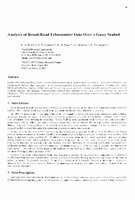| dc.contributor.author | Boyle, Frank A. | |
| dc.contributor.author | Chotiros, Nicholas P. | |
| dc.contributor.author | Pace, Nicholas G. | |
| dc.contributor.author | Bergem, Oddbjorn | |
| dc.contributor.author | Pouliquen, Eric | |
| dc.date.accessioned | 2018-10-11T14:08:07Z | |
| dc.date.available | 2018-10-11T14:08:07Z | |
| dc.date.issued | 1997 | |
| dc.identifier | 11441 | |
| dc.identifier.govdoc | CP-45 | |
| dc.identifier.uri | http://hdl.handle.net/20.500.12489/401 | |
| dc.description.abstract | Calibrated echosoundings from a well-characterized gassy seabed were examined. Acoustic reflection was significantly higher than expected. It is hypothesized that gas bubbles are responsible. Anomalously high levels of reflection appear at the edge of the spectral peak, possibly associated with nonlinear conversion of acoustic energy. An acoustic colormapping method was applied to the data, clearly showing its spectral character. The spectral features appear to carry relevant information about sediment interface roughness and gas content. | |
| dc.format | 8 p. : ill. ; digital, PDF file | |
| dc.language | English | |
| dc.publisher | NATO. SACLANTCEN | |
| dc.source | In: High Frequency Seafloor Acoustics (SACLANTCEN Conference Proceedings CP-45), 1997, pp. 49-56 | |
| dc.subject | Seafloor | |
| dc.subject | Gases | |
| dc.subject | Bubbles | |
| dc.subject | Echosounders | |
| dc.subject | Acoustic reflection | |
| dc.subject | Seafloor sediments | |
| dc.title | Analysis of broad-band echosounder data over a gassy seabed | |
| dc.type | Papers and Articles | |
| dc.type | Conference Proceedings (CP) | |
